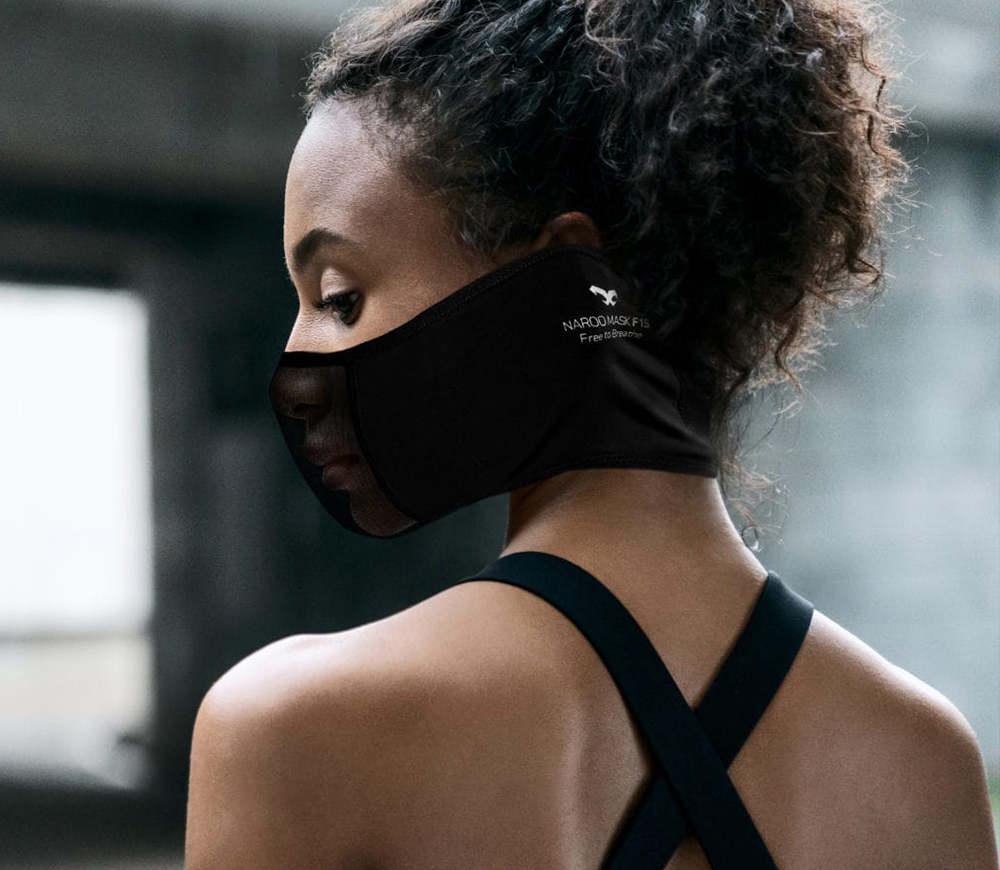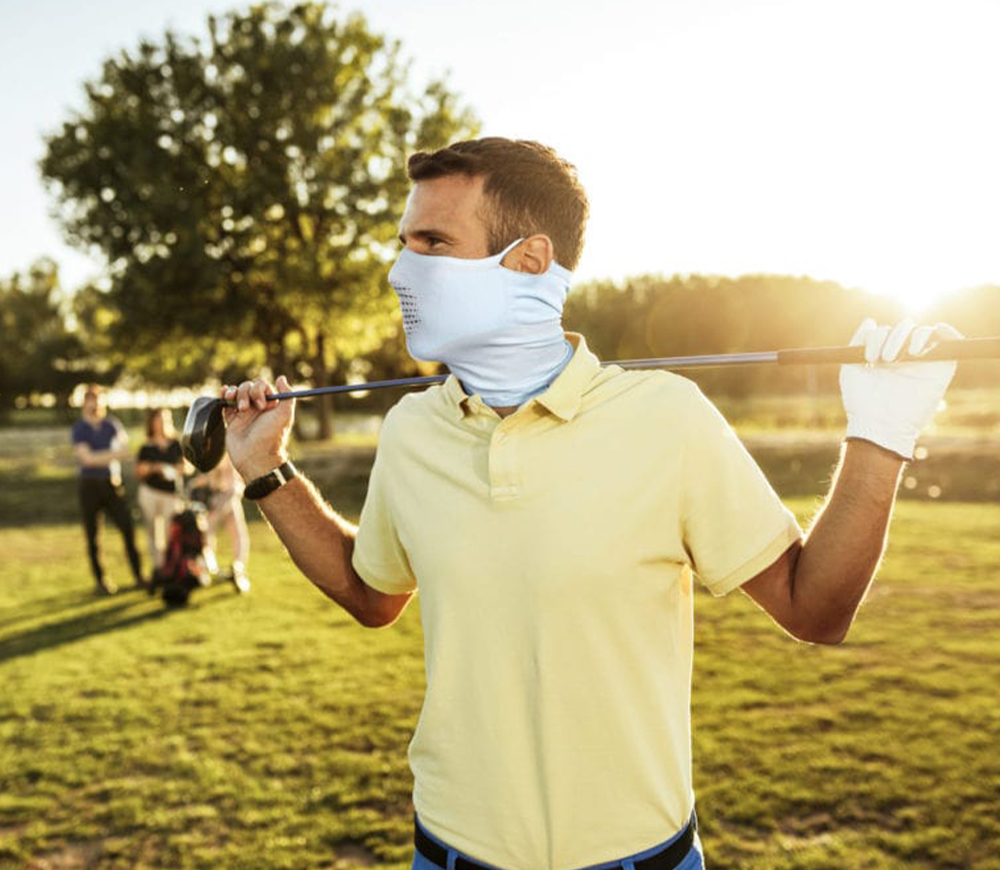In the high heat of summer, the number one concern on most people’s minds is staying cool. When you’re an athlete, especially one whose sports relies on heading outdoors, it requires a bit more preparation to ensure that you stay safe. Let’s take a look at how to stay safe in the heat and how a face gaiter can help. But first, what can happen if you unsafely exercise in the heat? Heat Illness There are a number of different heat-caused illnesses that can strike if you’re not prepared. When you are under hydrated, exposed to too many UV rays, stress your body by working in the heat, and constantly out in the sun, you may be vulnerable to a heat sickness such as “heat illness.” According to the Centers for Disease Control and Prevention, these symptoms can be heavy sweating, cold pale clammy skin, fast weak pulse, nausea or vomiting, muscle cramps, tiredness weakness, dizziness, and/or headache. Doesn’t sound fun, right? Definitely not. So how can we prevent these symptoms? Preventing Heat Illness During Sports There are several key points in preventing a heat illness while practicing sports. Hydration: This is key during any time of year and in any weather conditions. But during the summer when your body sweats more to cool itself, your water intake should increase to help your body’s natural cooling system. Stop frequently for water. Dehydration can increase the strain on your heart and temperature regulating systems, which in turn decrease your ability to perform at your best. Add a pinch of sea salt into your water bottle to regain lost electrolytes as well. Shade: As much as we want to power our way through the sun and the heat, a key to exercising in summer is to be sure that we rest and get enough shade. Our bodies need the chance to cool and acclimate to the heat. Do shorter bursts of aerobic activity and take frequent shady, water breaks. Exercising in the morning or evening, when the sun isn’t as high and the UV rays aren’t as powerful can also help you stay safe and perform at the top of your game. Also, UV rays can cause skin damage. Avoiding the strongest rays will keep your skin safer. Acclimatize: This is just a fancy word for letting your body get used to working out in the heat. Start with shorter training sessions and work your way up to longer ones as your body gets used to the heat, the sun’s rays, and often, the humidity. Humidity can stifle your body’s ability to self-cool because of a decrease in the evaporation of sweat. Awareness: Know your body and its signs. Keep track of how you’re feeling, how your body is responding, and don’t push it beyond its limits. To perform at your best, you need to give your body what it needs, including rest, shade, and hydration. How to Wear Face Gaiters in the Heat Wearing a face gaiter in the heat is possible and can be safe. In order to be so, the face gaiter has to have several key points to make sure you are comfortable and can perform at your best. Breathable fabric: A mask worn in the summer needs to have breathable fabric that allows the most intake of oxygen possible so you can power your body with the fuel it needs. NAROO’s F1S is made of MICRONET™, a nylon blend with an exclusive knit that is breathable and comfortable against the skin. The reverse side of the F1S has a SPAN MESH fabric that allows for clear, unrestricted and unfiltered airflow. Washable: Unwashed masks can retain sweat, salt, and other particles that can make a second, unwashed use of the mask less effective. Washing masks between every use is paramount. The F1S can be washed over 100 times without losing its effectiveness. Cooling: Moisture-wicking water-repellent fabric will help the mask disperse sweat and condensation from the nose and mouth and keep you dry (soggy masks are no fun!) and cool. It will help sweat evaporate in humidity. UV Protection: A face full of sun lotion can be sticky and drippy, so a mask can be an alternative to UV protection without the creams. The F1S’s SPAN MESH will keep your skin safe from the sun, and as an added bonus, also from wayward insects. F1S Bonus: MICRONET™ fabric technology also filters harmful particles as small as 1.7 microns in size, protecting you from pollen, pollution, and other harmful particles. A few extra tips are to choose a lighter color mask (the F1S in white) to reflect the sun’s rays and keep you cooler, and to follow local heat safety guidelines. Shop our mask selection to choose the best summer time mask for you.
What’s the Difference Between a Sports Face Shield and a Workout Face Shield? From defense to disease prevention, masks are one of the most commonly used products today. Sports, in particular, require frequent usage of masks for a multitude of reasons. Be it for managing uncomfortable weather conditions, protecting the face from injury or just breathing less polluted air, masks have always been the answer. However, amateur sports enthusiasts may often confuse sports masks with a workout face shield, or vice-versa. Since each category of masks is manufactured to meet a specific purpose, anyone taking sports seriously needs to know the difference. Donning the wrong mask at the wrong time for the wrong reason can cause injury, discomfort, inconvenience, and compromised performance. So, let’s start with the obvious questions. Workout Face Shield? Essentially, training masks (also known as altitude masks or elevation training masks) are used to simulate high altitude conditions by stressing the body while exercising in lower altitudes. It is used to make breathing as hard as it would be in higher altitudes, so as to prepare the wearer for an environment in which breathing would be more difficult for them. Training masks limit the amount of air the wearer can inhale. Through repeated usage while training, it strengthens respiratory muscles by making them work harder. It helps accelerate physical performance, improve endurance, and prepare the body to function optimally in challenging respiratory conditions. View this post on Instagram A post shared by NAROO MASK | Official (@naroomask_global) What are Sports Face Shields? Sports Face Shields are specifically designed to handle sports activities. They are primarily meant to protect the wearer’s respiratory system from environmental factors while in the midst of strenuous activity. For example, a sports mask can be useful when you are running in a city with high smog levels, as it would protect you from inhaling polluted particles from the air and protect your lungs from too much damage as you inhale more oxygen more frequently during exercise. Of course, sports masks come in multiple variants to help protect the body while performing different activities or while operating in diverse environments. A few of these include: • Balaclavas: Headgear designed to cover most of the face, except the eyes and mouth. It is especially useful while motorcycling or engaging in winter sports, especially in snow climes. Their most basic functions are to protect from the wind, cold, and dust. Face masks/Face Covers: Masks or facial covers are equipped with filters that prevent the wearer from breathing in pollutants, pollen, or dust particles. These are useful when athletes have to train or perform in dusty locations or areas with high levels of pollution. Of course, there are also masks without filters that are made to provide protection from elements such as UV rays, strongs winds, jarring cold, flying insects, etc.Tubular masks/neck gaiters: Often made of materials meant to provide warmth (fleece, wool, etc.), it is shaped as a closed tube that one can slip over the head. This face covering also protects the neck, and can be pulled over the mouth and nose to protect against wind, debris, fumes, and other irritants.Driven by a desire to help athletes and sports enthusiasts deliver optimal performance, NAROO provides a catalogue of industry-best sports masks. We offer a variety of sports masks (running masks, cycling masks, masks for winter sports, and more) , each designed to align with the requirements of specific sports, weather conditions and the athlete’s performance level. For us, comfort, breathability and protection are the priority. Sport masks vs. Training masks – How are They Different? Simply put, one protects while the other strengthens. Sports masks are worn to ensure that the wearer does not inhale undesirable elements (fine dust, pollutants, insects, pollen, etc.). It is also meant to protect much of the face, including nose and mouth from inhospitable weather (cold temperature, strong wind, harsh sun, etc.). On the other hand, training masks restrict air flow to the wearer’s nose and lungs. This is done to strengthen their respiratory system by making it work harder in stressful conditions. Primarily, training masks are used to simulate high-altitude breathing conditions while training in lower altitudes. Since there is less oxygen and breathing naturally becomes more laboured when higher up, a training mask is a great way to acclimatize the body to these conditions without actually having to go to those heights. This is especially useful when preparing for strenuous treks or other physically challenging activities in challenging mountainous terrain. Benefits of Sports Masks Protect your airways: The right sports mask will make breathing infinitely easier during physical exertion than other face covers. While training, breathing quickens and you wouldn’t be able to consciously focus on avoiding dust or insects. But a mask equipped with filters can take care of that. It prevents dust, pollen, sand, bugs, and much more from being inhaled and tainting the airways and lungs. Enables greater focus: With breathing woes in control, the athlete can focus on nothing but their performance. They won’t have to deal with irritants like smog and dust. Additionally, adequately equipped masks will keep them wealthier in the long run, by preventing the inhalation of undesirable air particles. Protect your skin: Between UV rays and airborne irritants, your skin is exposed to a lot while you exercise. A great sports mask that protects your airways will also protect your skin from the same irritants. View this post on Instagram A post shared by NAROO MASK | Official (@naroo_global) Homemade Solutions – How Effective are They? Many athletes choose to wear a scarf, neck warmer, face bandana, balaclava mask or ski mask around their mouth and nose when training in the cold. However, while this does trap the warm, moist air they exhale, these items are quite uncomfortable, especially during intensive training sessions. Additionally, goggles get fogged up, causing visibility issues hence cutting down on performance capability. They are also not easy to breathe through, adding further deterrents to performance. NAROO’s breathable sports masks have been inspected and certified
Key takeawaysWithout protection, ultraviolet( UV) light from the sun and other sources can be dangerous.Sunscreen is a great way to cover yourself, but there are numerous other helpful tools.Wearing face covering is a good option how you can protect your most valued part of body. 5 Ways to Protect Your Skin From the Sun Without Sunscreen From increasing your vitamin D levels to improving your mood, sunlight can improve your health in many ways. However, unprotected sun exposure can be unhealthy. The sun produces harmful ultraviolet (UV) radiation that can cause problems such as sunburn and sun poisoning. It can also cause other side effects, such as premature aging, skin cancer, and eye damage. And it’s not just the sun. Artificial UV sources such as solariums are also harmful.A daily sunscreen goes a long way in protecting you from UV rays. But there are other ways to protect yourself. Read on for helpful skin protection strategies that will come in handy on your next beach vacation or other outdoor activity.Everyone knows that exposure to ultraviolet (UV) radiation increases the risk of developing skin cancer, but most will never properly protect themselves when outdoors being active under the sun. UV rays are the main cause of sun-damaged skin. By harming the skin’s cellular DNA, excessive UV radiation encourages genetic mutations that can lead to skin cancer.It’s not only the sunbathers who are at risk of developing skin cancer. We may be exposed to high levels of UV every second that we are outdoors, no matter the activity. Even light sun exposure adds up over time and increases the chance of health concerns in the future.Although the sun’s heat is at its hottest in Summer, it’s not the only season to worry about for strong UV presence – even on cloudy, cold days where you might feel protected from the sun, harmful rays are still present even if it doesn’t appear to be. Proper protection is essential throughout all seasons.But how do we shield ourselves from this ever-present radiation?During outdoor activities, sunscreen alone isn’t able to block all UV rays. Sunscreen is only effective for around two hours, after which it needs to be generously reapplied. This can be inconvenient when in the middle of an activity, competition, or task: you may be unable to reapply sunscreen on your skin in time or simply forget to do it again at all. Facial skin is also too delicate and sensitive for large amounts of sunscreen and many people do not enjoy the thick, sticky feeling of wearing it on their skin.1. Cover yourself with cooling neck gaiter or face covering mask and a hatYou can protect yourself from UVA and UVB rays by covering your skin with protective clothing, face covering and a hat. However, certain garments offer more protection than others. You can look for clothing items with a UV Protection Factor (UPF), which indicates how well the fabric protects your skin from UV rays. For example, A UPF 50 shirt blocks approximately 98% of the sun’s UV rays. The Skin Cancer Foundation (SCF) requires a UPF of 30 or higher to award the seal of recommendation for effective sun protection.However, your clothing doesn’t have to have an SCF rating to provide sun protection. The degree of protection your clothing provides depends on several factors, including:Colour:Fabric color is one of the most important factors in determining UV protection. Also, research shows that dark colors such as blue and red block sunlight better than lighter colors. This is because it absorbs more UV rays. material:Clothing made from tightly woven fabrics such as denim, wool, and polyester are less likely to transmit UV rays than light, loosely woven fabrics such as unbleached cotton or mesh. You can test the clothes by holding them up to the light. If the fabric is see-through, it may not provide enough protection.Style:It helps to cover the skin as much as possible. This can be done with certain styles of clothing such as long-sleeved shirts, wide-brimmed hats, long pants or skirts. fit:Loose clothing can reduce sun exposure. Because tight clothing can stretch or tear, allowing more UV rays to reach your skin.Wet clothing is also less protective. So don’t forget to change your clothes when you disembark if you plan to explore the pools or the ocean.NAROO sports masks are ideal for defending your most delicate skin and eliminating health risks in the future. Our masks simultaneously provide complete coverage and allow for easy breathing and comfort in any environment, so that you can forget the fear and focus on the fun. 2. Wear sunglasses to protect your face and eyesUV rays also damage the eyes, eyelids and the delicate skin around the eyes. Luckily, wearing sunglasses can help protect these areas and reduce the risk of conditions like cataracts.But just like your clothes, not all glasses are created equal when it comes to blocking sunlight. may be effective in protecting One way to check the effectiveness of sunglasses is the Eye Sun Protection Factor (ESP®). ESPF measures how well a lens blocks light transmission and UV reflection.If your sunglasses don’t have an ESPF rating, you can look for other factors. The American Academy of Ophthalmology recommends looking for sunglasses that block 99% to 100% of all types of UV rays.3. Use an umbrella or parasol when going outUmbrellas aren’t just for rain. Umbrellas and parasols can be used to prevent UV rays from directly hitting your skin. However, research shows that it does not block the scattered or diffuse UV rays commonly found on beaches. Therefore, this shading tool works best when used in conjunction with other sun protection strategies, such as wearing sunscreen and protective clothing.4. Avoid UV raysThe sun is not the only source of harmful UV rays. Some man-made sources include:Solarium:Tanning beds emit dangerous UVA and UVB rays similar to the sun. This, along with other forms of indoor tanning, can increase your risk of skin cancer and prematurely age your skin.It can also cause eye damage and weaken your immune system.Mercury vapor lighting:Mercury lamps are designed to provide long-lasting light. People



